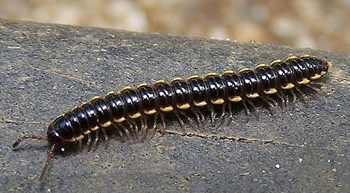6 Amazingly Complex Military Strategies Used by Bugs

If you see a bunch of ants running crazily around on the sidewalk, you don't stand there and wonder what their master plan is. They're ants -- they're probably just blindly scurrying in random directions, waiting to get stepped on. But we should stop every now and then and remember that, from a distance, everything humans do also looks like pointless bullshit.
Sure enough, when scientists look closely at insects, we find that it's startling how organized and strategic they can be in their movements. And when you watch insects go to war, well, it pretty much looks just like us ...
Beetles Make Shields ... and Join Them in Battle Formation
Remember in 300 when all of the Spartans formed up with their shields to create one solid wall of defense? The Romans did it, too, a tight group of soldiers raising their shields on all sides, creating an unstoppable sandal-powered battle tank. Well, here's what it looks like when a bunch of baby tortoise beetles do the exact same thing:
First of all, when we say that these bugs use shields, you might assume that means they're born with a hard shell, but as larvae they actually start out just as squishy and vulnerable as a month-old banana. So, they have to quickly learn to overcome this little inadequacy by building crude shields out of their own dead skin and feces to wield against predators. Let's say that again: The tortoise beetle larva protects itself from danger by swinging around a poop shield.
But even the advanced shit-on-a-stick approach to protection isn't always enough to safeguard the beetles, so some larvae came upon the brilliant idea to band together and join their shields to create an impenetrable barrier of +5 protection and +10 total gross-out. Their version of this phalanx strategy is known as cycloalexy. The guards keep their fecal shields turned outward, while the feeders inside the circle keep their shields held overhead. When something gets too close to their defensive barrier, it usually gets the crap beaten out of it by the bugs' crap cudgels.
Bees Lay Siege to Enemy Hives for Weeks at a Time

If you know anything about the history of warfare, or have just seen the second Lord of the Rings movie, you know what ancient human warfare looked like: An army would decide to invade a city, the opposing army would hunker down behind its walls, and the two sides would settle in to a long and bloody siege. Well, want to know what it looks like when a swarm of bees decides to take over another hive? Pretty much the same thing:

Yeah, that massive pile of corpses is the horrific aftermath of a bee siege. Experts have found that prolonged assault on an enemy's fortification is a battle strategy strangely favored by the Trigona genus. Large swarms of them will travel to another colony and buzz around outside until the guards come out of the hive and start grappling with them in midair. Once they've incapacitated each other with their jaws (they don't have stingers), the bees will then tumble to the floor and start wrestling to death, creating a fuzzy, twitching carpet of corpses and hatred that would make Genghis Khan queasy.
And when we compare this to a drawn-out siege, we mean it -- the fighting can last anywhere from a few days to a few weeks. The attackers will settle in, occasionally charging the enemy, trying to win a battle of attrition. And just like human wars, they tend to spread -- once word of the fighting gets out (via alarm pheromones bees excrete when they're locked in mortal combat), other hives join in. They've observed bees from up to seven nearby hives all swarming to get in on the action in one massive orgy of death.
Ants Use Mercenaries and Forge Alliances

As we've learned from various historical documentaries, a specialized full-time fighting force is the key to military dominance, which is bad news for farmer ants. Farmer ants are great at many things, like cutting up leaves, covering them in fungus, and nurturing that fungus into a delicious meal. Sadly, their ability doesn't translate well to not being raided by the bigger genus Megalomyrmex, which likes to wander into the farmer colonies and plop down on their couches, demanding to be fed.
And, yes, that does sound like a pretty sucky situation, but you know what sucks slightly more? Having another army of raider ants swarm your nest, kill you, and take away your babies while cackling maniacally the entire time. Because that is a constant threat the farmer ants live under, which is why they're OK with having the Megalomyrmex hanging around and stealing their lunch.
You see, as soon as the aggressive raider ants appear, all ready to scorch the hell out of the farmer colony, the larger moocher ants will suddenly rip off their popped-collar shirts, run outside, and thoroughly hand the attackers their own asses.
After that, having their fridge emptied out from time to time in return for not being brutally killed starts to sound like a pretty sweet deal, so the fungus farmers agree to feed the Megalomyrmex warriors if they hang around and act as their Seven Hundred Samurai.
Ants aren't averse to less-direct interspecies alliances too, especially against Formica sanguinea, aka slave-maker ants, which are exactly what they sound like. In one instance, a colony of low-hierarchy ants was being chased by slave-makers until they wandered into the territory of the L. fuliginosus ants. The would-be-slave ants entered the new turf unhindered, but when the slave-makers went in after them, the L. fuliginosus ants descended on the insect plantation owners and fought them off.

While this was happening, a fourth species created a 30-foot-long cordon to protect the weaker ants. They didn't do it to later take them as slaves themselves, but rather because the three species genuinely seemed to be working together against the Formica sanguine menace, united under a shared belief of "Man, fuck those slave-maker assholes."
Millipedes Create a Demilitarized Zone 140 Miles Long

Human society is made up almost entirely of walls and borders, and we tend to be overprotective of them. The Chinese built a wall to keep out the Mongols, the Romans built a wall to keep out the Scots, and the Americans built a fence to mildly inconvenience Mexicans. All of those stand to this day as a testament to man's distrust of man, which inexplicably pales in comparison to how much Australian millipedes apparently hate each other.
It has been observed that two species of millipede from northwest Tasmania have claimed their own territory in different parts of the island with a 330-foot-wide "mixing zone" between them, which the bugs can tentatively enter but never cross. This is known as a parapatric boundary (sort of like an insect demilitarized zone), and they're actually quite common, except that this one is 143 miles long, or about twice as long as Hadrian's Wall.
Parapatric boundaries normally follow some sort of geographical feature. These millipedes, however, seem to have come up with theirs using nothing but arbitrary mutual agreement, crossing hills and rivers, ignoring climate and vegetation, and paying no mind to rock and soil.
When asked to explain this, the scientists basically threw up their arms and said, "The heck if we know. Magic, maybe?" Personally, we can't help but imagine two millipede generals bent over a map, discussing their invisible border while wearing tiny army hats and uniforms and ... hold on, we need to jot down an idea for a children's book.
Termites Have a Highly Organized Military

Do not be fooled by the frankly slanderous portrayal of termites in the movie Antz. Rather than being slobbering monsters that rely on brute strength, termites are actually closer to the insect version of ancient Spartans ... if Spartans walked around with guns that shoot glue mounted to their heads.
Their bizarrely defined 300 abs are too small to photograph without a special lens.
But merely possessing a caste of super soldiers means nothing unless you can use them correctly, and this is where shit gets downright scary. Unlike other hive-minded insects, whose tactics are more or less "start scratching and biting in that general direction," termites have developed some unnervingly human-like military strategies.
Workers of the genus Hospitalitermes, for example, go foraging for food out in the open by marching with an armed convoy. When the day's foraging begins, a group of soldiers exits the nest first, followed by a tight line of workers and soldier escorts. As the party ventures forth, the soldiers move to the flanks to guard against attackers. Workers keep to the center of the line, cutting and hauling food back to the nest while the soldiers ward off threats with their gunk-spewing face guns.
Then there are the Macrotermes termites and their detailed battle plans for defending the home nest. If ants ever come over to pillage and manage to breach their walls, the termite soldiers will drum on the walls to alert the colony of danger, sending an alarm reverberating throughout the entire nest like an air raid siren. When that happens, soldiers immediately charge out of the hole, sacrificing their lives to hold back the enemy, while workers scramble to seal up the damaged wall. In a pinch, the soldiers will even block the tunnels with their heads. OK, so maybe they're not geniuses. But still ...
Ants Leave No Man Behind

If there's one thing that separates humans from animals, it's our willingness to help one another in a time of crisis (also, animals can't ride bicycles for shit). Insects are worst of all -- they operate on a hive mentality where a single individual doesn't even register. They'll mindlessly sacrifice wave upon wave of excess bodies for the good of the colony, without a second thought ... is what most people think, and also the exact opposite of what science discovered as far back as 1874.
Yes, way back in the 19th century, biologists observed certain ants taking time to dig out their comrades who had become trapped in sand. Modern scientists then decided to test this supposed ant compassion by setting up an experiment where they buried a bunch of ants ensnared in nylon string.

Surprisingly, instead of just marching blindly on, the ant's nestmates actually launched a rescue mission to free the prisoner, carefully digging out the sand and chewing through the string until the victim was free.
Ants caring for their wounded might sound like a whimsical bit of propaganda from the anti-pesticide, pro-unicorn farts lobby, but their camaraderie actually goes much further: Ants will plunge headfirst into battle with a deadly antlion to save a comrade from being eaten. In one test, researchers threw ants into an antlion pit (seriously, scientist guys: When the ants inevitably rebel against us, we're blaming you), and when it would grab a victim in its jaws, the other insects would try to free it by biting and stinging the antlion. Once, the rescuer herself ended up being next on the antlion's menu, but rather than fleeing the scene, the newly freed victim returned the favor, valiantly staying in the fight to save her buddy.
Of course, ant loyalty only extends to the colony's boundaries. In the experiment where ants were tied up with string, only ants from the same nest would bother saving Private Ryant. If ants from a separate nest were on the scene, the prisoner was ignored, tortured, or sometimes even killed while it couldn't fight back. So, yeah, they're not like humans at all!
You can bug Alan on Twitter, where his puns don't get much better. When Mr. Yee isn't training kung fu mantis bodyguards for the inevitable Bug Wars, he's usually making T-shirts and writing his daily online fortune cookie.
Related Reading: We've got a feeling you aren't scared enough of ants right now. This article should help. Still not scared? You should know they're growing immune to our poisons. In fact, if these Argentine ants have their way, the whole planet will be sporting six legs before much longer.
Always on the go but can't get enough of Cracked? We have an Android app and iOS reader for you to pick from so you never miss another article.













